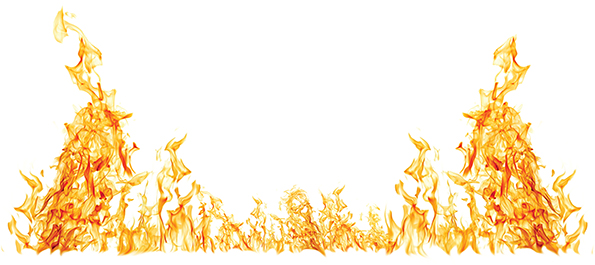
 BUSRide Maintenance gathered representatives from two leading fire-suppression system manufacturers to discuss the ever-present threat of bus fires, and the recommended technologies and best practices to detect, suppress and extinguish bus operators’ worst nightmare.
BUSRide Maintenance gathered representatives from two leading fire-suppression system manufacturers to discuss the ever-present threat of bus fires, and the recommended technologies and best practices to detect, suppress and extinguish bus operators’ worst nightmare.
The panelists for this discussion are:
Ed Ruggles – director of marketing and sales – Fireaway, Inc. / Stat-X
Scott Starr – director of marketing – Firetrace International
Describe the technology and mechanisms at work in your proprietary fire suppression system and associated products.
Ed Ruggles: For buses and coaches, Stat-X technology is a bit different than most. The current trend in the motorcoach industry is to move away from dry chemicals.
Our technology is neither a dry chemical nor a clean gas; rather an alternative to a clean gas. We use a proprietary blend of micron-sized particulates of potassium housed in an unpressurized stainless container for suppression. Upon activation, an ultra-fine suspension of highly-ionized potassium fire-fighting particles will fill the protected area and suppress the fire. Stat-X is extremely affective on suppressing fires in engines, battery and electrical compartments.
Scott Starr: Firetrace systems originated from a growing need for reliable effective fire protection in harsh engine enclosures. These systems employ our proprietary pressurized polymer Firetrace Detection Tubing, which is excellent at quickly detecting a small, growing fire.
One noticeable feature is how it remains resilient even when covered in road grime. This tubing tolerates vibration, fluctuating temperatures and engine cleaning operations without any false activations.
Can you cite a recent event that exemplifies the constant threat of bus fires and validates your product?
Ruggles: A recent fire event reported by various news outlets describes a bus fire on Sydney Harbour that was initiated by an electrical malfunction in the engine bay at the back of the vehicle. In a final report into the incident, the investigators said it was likely that the fire was sparked by a short-circuit of auxiliary alternator cables where they crossed the edge of a rear-chassis rail. This bus did not have an integrated fire-suppression system.
Starr: The threat of fire onboard a bus is very real and ever present. A quick search of the news, or better yet Twitter (which offers almost real-time monitoring), shows bus and school bus fires occur almost daily.
What is your loudest, most emphatic message to bus and
coach operators concerning fire safety and onboard fire suppression systems?
Ruggles: We encourage owner-operators and municipalities to expand their view on procuring suppression systems that meet the hazards present and steer clear of low cost alternatives based on budgetary constraints. As more data becomes available regarding root causes of fires in buses and motorcoaches, I believe these folks are starting to see that the inexpensive alternatives might not deliver the results and benefit they really need or require. Selection of the solution to meet the hazard and not the budget is always the best path forward.
Starr: We know bus and coach operators face a lot of priorities that compete for budget dollars. We also know that a fire-suppression system certainly is not one that carries immediate visible value. Nonetheless, ask any operator who has endured a bus fire to name the greatest incurred loss. In most cases the answer will be the company’s loss of customer confidence, which in the long term may far exceed any immediate financial loss.
What do bus and coach operators need to know and understand to be compliant in fire safety, protection
and suppression?
Ruggles: Operators are not only protecting their assets, but also the people who rely on them to get from point A to point B safely, as well as the transportation network they are a part of. Do your homework on suppression options. Understand what potential fire hazards exist and look for the best solution for your platform or fleet. Once you have a solution integrated on the vehicle, it is extremely important that you keep it maintained and in proper working condition.
Starr: New approvals are now coming out of Europe specific to buses known as UNECE r107 and the RISE Institute’s P Mark. It is important to note that there are no such bus-specific approvals in the US. Nonetheless, while these approvals may not be enforceable in this country, they do provide an excellent framework for everyone as to the effectiveness of the assorted options in vehicular fire suppression.
These approvals also spell out the limitations for the systems, such as size, nozzle count and design limitations for an engine compartment’s volume and certify that the systems are effective in real-world bus fire scenarios and are evaluated not only against fire types and location, but also with varying airflow to ensure the systems will function as intended in the event of a fire.
How does optimum fire protection differ from one mode of bus transportation to the next, i.e., transit buses, motorcoaches, small and midsize shuttles, and
paratransit vehicles?
Ruggles: With new technological advances, there is an expansion of fleet configurations and power options that include small and midsize shuttles, extended articulated buses and motor coaches, hybrid and all-electric vehicles and any vehicle in between.
Each new platform or integrated technology comes with its unique hazards and the potential for fire, which operators must address. Selecting the best fire suppression solution must be part of the initial build process; determined only by performing a thorough hazard analysis.
Suppression systems should incorporate both automatic and manual means for system actuation.
Detection is a critical function of any automatic
suppression system.
The best way to determine the correct fire suppression solution for your platform is to begin the selection process with an extensive hazard analysis.
Starr: Fire protection has far more to with system design that will accommodate the many different environments in the engine compartment – accounting for air flow and demonstrated hazard areas.
ABC is by far the most common fire suppression agent. It has shown in approval testing to be the most applicable against the range of fires found in an engine compartment on any type or size of bus.
Firetrace Technologies recommends ABC for its effectiveness against all three fire classes: A – common combustibles; B – flammable liquids; and C – electrical fires.
What is the difference between a standard installation and a fully-customized fit? How far can a fire-suppression provider take a custom install?
Ruggles: Some platforms will have a one-size-fits-all suppression system. The systems are designed and tested to fit a fleet that has limited configuration options. This type of system would fit into the standard installation definition.
Custom installations are those that have expanded functionality or options. This could include both internal (occupied areas, engine bay, battery compartment and similar zones) and external fire suppression (tires, fuel tanks, under chassis, anything outside of the enclosed compartments).
Starr: To operate effectively, nearly every different model of bus deserves a custom fitting. While manufacturers provide a design and installation manual that presents design limitations, each bus has different challenges that need addressing in the design and installation to offset airflows and ensure the areas of highest risk receive adequate protection for the task.
What are some of the tell-tale signs that a potential vehicle fire is breaking out?
Ruggles: Some tell-tale signs for potential vehicle fires are from illuminated operating warning light sensors — specifically tires, breaks and engine or smoke. Maintenance techs are advised to address and correct any obvious lubricant or fuel leak. The old saw, where there’s smoke, there’s fire certainly comes to mind as well.
Starr: Not following suggested maintenance and cleaning are some of the most frequent causes. However, the reality is that we are talking about a mechanical environment where a fire can be both the result of long-term visible developments as well as instantaneous non-visible failures.
What preventative steps must drivers and maintenance techs take to further mitigate the dangers of a fire onboard?
Ruggles: A fire-suppression system will only perform to its optimum level with proper maintenance. Fire suppression manufacturers provide inspection and maintenance instructions for their respective systems. Drivers and maintenance technicians use these to confirm the system will perform as needed during a fire event. It is extremely important they address and correct any defect discovered during a system inspection or routine maintenance — no matter how minor — before the bus returns to service. Never skip or delay scheduled maintenance and system inspections.
Starr: Again, following the prescribed maintenance of all bus systems is a critical first step. For drivers, be familiar with the proper fire response, including manual activation of the systems and the necessary steps to quickly and safely evacuate the bus.

While the use of suppression is important, the selection of the interior components is much more important. The October 20, 1993 Federal Register Docket 90 provides testing for materials, this should be specified for every bus that receives federal tax dollars. This document essentially provides tha t same protection as found in passenger railcars. Evacuation time is increased substantially, this is needed when transporting ADA equipment.